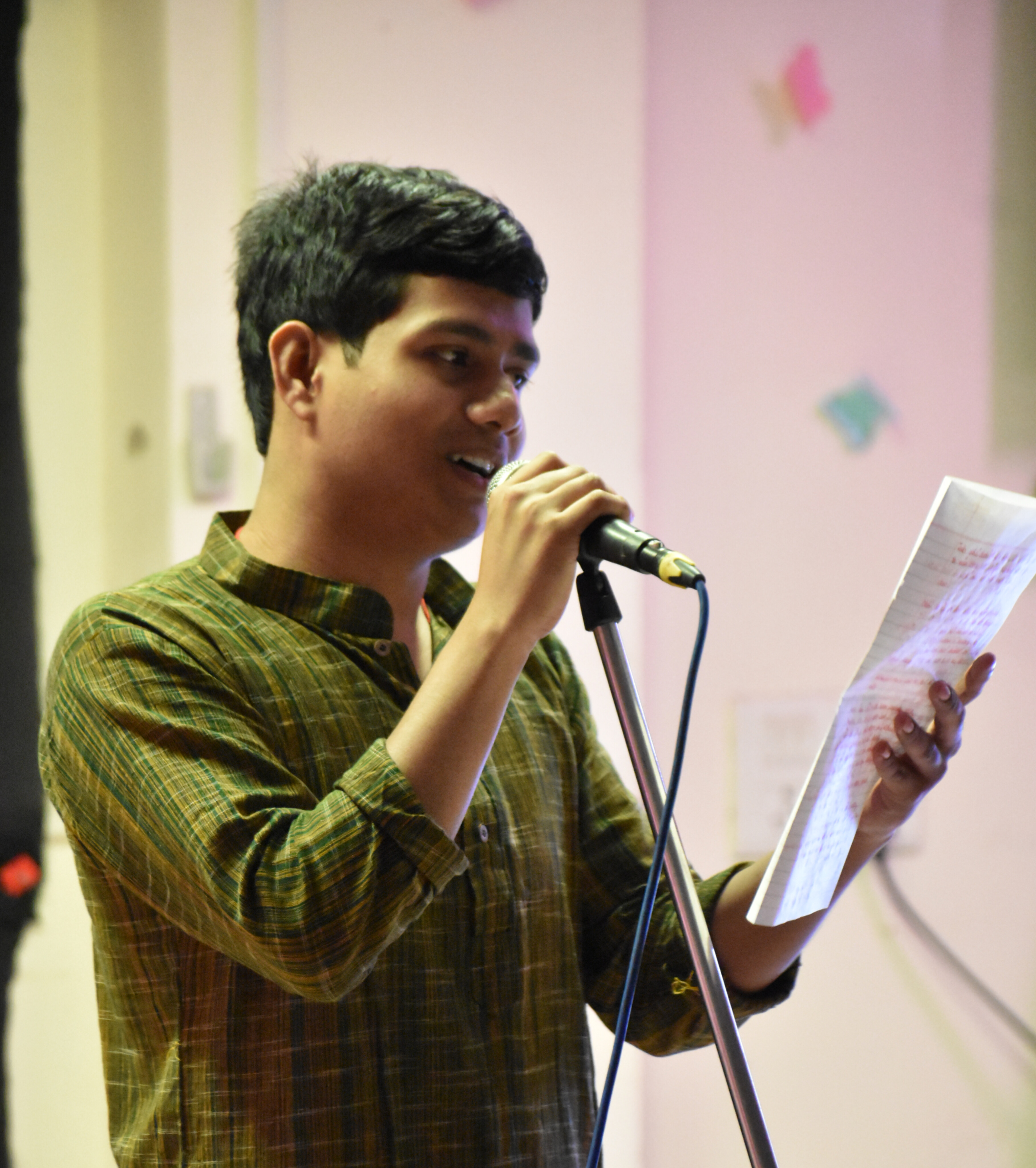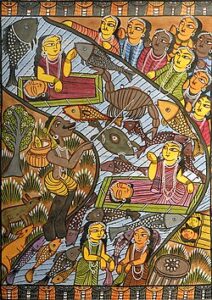
INTRODUCTION AND HISTORICAL OVERVIEW
Mangal Kavya, a genre of religious narrative poetry that emerged in the 13th century of medieval Bengal. The main argument that is referred to as its rise was the increasing number of social upheavals, such as the attack on Bengal by Bakhtiyar Khilji, and the condition of lower-caste people under the various rulers. The integral part of this rise of Mangal Kavya was that it added a voice to the subaltern section of society, who were downtrodden due to the Brahmanical hegemony. This whole eulogy of poetry highlights three important goddesses and gods: the snake goddess, Mansa; the folk goddess, Chandi; and the non-Aryan god, Dharmathakur. They are infused with an idea of Pan-Indianization.
The actual meaning of the term Mangal means “auspicious or sacred” and depicts the power and glory of these gods and goddesses. This book has three types: Manasamangal, Chandimangal, and Dharmamangal. For instance, the Manasamangal talks about the story of the goddess Manasa and how she should be worshiped. The Chandimangal talks about the rise of goddess Chandi through a popular folklore, Kalketu-Phullara, while the Dharmamangal talks about the god Dharmathakur. In the early modern period, there was a rise of many other Mangalkavya, such as Anandamangal, Suryamangal, Bhavanimangal, and many more.
ORAL TRADITION AND DISSEMINATION

Chandimangal
Even though this Mangal Kavya is a eulogy of various poetry, it gained popularity through oral tradition or oral performance. The main idea behind the manuscript was that it should be sung and chanted properly by an individual or the community, or by the villagers in praise of these goddesses and the gods, not meant to be read silently. Their wording is in the form of poetry, and they are rhythmic in nature, which helps one to memorize them easily and make them singable. In some parts of rural West Bengal and Bangladesh, these are sung in religious festivals and village gatherings of these gods and goddesses, such as Chandi or Manasa Puja.
Based upon oral tradition, few people used to roam village to village by singing the Mangal Kavya in praise of gods and goddesses. There were Gayakas (village singers) who used to sing and chant for the village audience. The main feature was that they were non-canonical and even vernacular, which was easy for everyone to remember and recite. In Bengal, the Manasa worship was done by reciting the Manasamangal, and it was recited by the grandmothers of the family, mainly the elderly female ones.
VISUAL AND PERFORMATIVE ARTS ASSOCIATED WITH MANGAL KAVYA
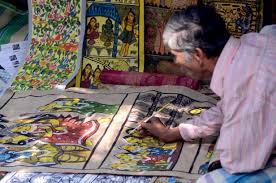
Patachitra
The first and foremost one is the Patachitra (scroll painting and song performance). In Bengal, Patachitra refers to the painting on the cloths that involves various depictions from religious to rural village life, painted by a community called chitrakars or the Potuas. They included both Hindus and Muslims, and these secular beings create paintings on a piece of cloth illustrating the myth episodes. They are in the form of a scroll. When they open up the scroll one by one, they recite the stanzas in the poem of poetry, or they used to sing them. The stories are depicted in the form of episodes in a narration style and include three main parts: Kahani, Mahatmya, and Bhavita. Modern studies say that the potuas also depict the stories taken from Mangal Kavya, such as the birth of goddess Manasa.
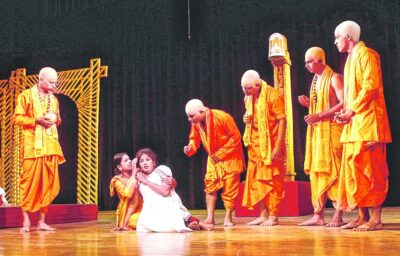
Jatra
Another traditional open folk theater in Bengal is the Jatra. This is nothing but a drama or theater that takes place in the open air, infused in the form of dialogue delivery, and focuses on themes such as Radha Krishna. There are instances that tell us that Jatra also takes place based upon the stories presented in the Mangal Kavya, and it becomes dominant from the 16th century onwards. For example, a 16th-century poet named Mukundaram Chakravarti, who composed his Chandimangal, became so popular that it was dominant in various Jatra themes in rural early modern Bengal.

Source: Get Bengal
Next is the mask making and the ritual dance. From the very early modern period, the creation of masks became very popular, which is also called the Chauu dance of Purulia/Mayurbhanj and the Gambhira of Malda. In these performances, these masks are used to represent various gods and goddesses through the medium of dance. The mystical characters are dominant in this mask-making. These dances are performed in the Chaitra spring festival. In this case, Mangal Kavya is not that popular, but we find instances such as the mask of Goddess Chandi, taken from Ananda Kavya, which was popular in the rural areas of Bengal.
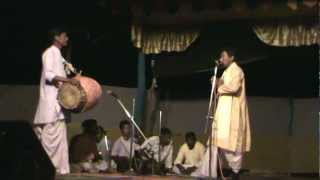
The last and most important is the folk music traditions (kirtan, bhatiali, etc.). This folk music tradition in Bengal is called the vehicle that popularized the Mangal Kavya to the grassroots level. It impacted the social norms and Brahminical dogmatism in the Bengal region. The Mangal Kavya, when sung in the form of songs, is called Mangal Gan, which means singing the poems of Mangal Kavya in praise of the gods and goddesses associated with it. By the 15th century onwards, the Mangal Kavya was sung in specific ragas such as Basanta, Mallar, Sri, Kaushiki, and many more and carried a Mangalsur tune.
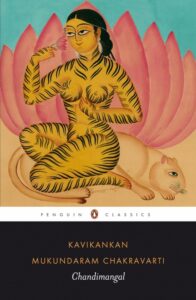
English version Chandimangal
CONTEMPORARY PRACTICES, TRANSFORMATIONS, AND REVIVAL
In the present scenario, the Mangal Kavya has undergone both decline and revival with a twist of creative renewal. In this urbanization, there has been an immense effort to preserve this creative form. The West Bengal government and various NGOs from West Bengal conducted workshops and conferences and even sponsored events to promote this art. For instance, the ‘Pingla Patachitra’ tradition of West Medinipur received a geographical tag in 2018, and UNESCO sponsored various programs conducting the scroll painting workshops.
Now, the Patachitra paintings depict various contemporary issues such as social justice, LGBTQIA+ rights, and many more. Exhibitions are taking place in various colleges and universities. Many scroll paintings that depict Mangal Kavya are being preserved in museums, and the Chandimangal by Anwar Chitrakar an exhibition in the UK. In sum, these paintings for commercial means have been shrunk, but their survival is showing in various preservation schemes taken by the government.
CONCLUSION
The rise of Mangal Kavya was one of the crucial movements that uplifted the subalterns of rural Bengal and gave them an identity of worship. In this current scenario, the rise of various kinds of social media has enhanced its reach, and even in many universities and colleges, a course on Mangal Kavya in Medieval Bengal is taught. Even at my university, Visva Bharati, a DSE course is offered during the 5th semester of graduation by the Department of History.
The course is Medieval Bengal, which covers various aspects, but the most dominant one is the rise of Mangal Kavya. This is how creative and cultural tradition is preserved in various universities and colleges. This Mangal Kavya is not only a bookish text or a manuscript; it is the voice of the subalterns who were being dethroned from society due to the dominance of Brahminical hegemony.
WORK CITED
- https://en.banglapedia.org/index.php/Mangalkavya#:~:text=It%20is%20believed%20that%20contemporary,who%20were%20neglected%20and%20oppressed
- https://www.britannica.com/topic/mangal-kavya
- https://sarmaya.in/guides/endless-scroll-the-genesis-of-bengals-pattachitra-art/#:~:text=Bengal%20Patuas%20or%20Chitrakars%20are,to%20generation%20among%20the%20Patuas
- https://en.banglapedia.org/index.php/Jatra#:~:text=Jatra%20a%20form%20of%20folk,and%20exaggerated%20gestures%20and%20orations
- https://archive.org/details/dli.ministry.16901#:~:text=This%20article%20described%20various%20type,of%20wood%20by%20the%20carpenters
- https://en.banglapedia.org/index.php/Music#:~:text=The%20age%20of%20the%20mangalkavya,38%2C%20Sitar%2C%20dampha%2C%20Khamak
- https://timesofindia.indiatimes.com/city/kolkata/traditional-pix-get-a-modern-pat/articleshow/70528043.cms#:~:text=Anwar%20Chitrakar%2C%20another%20celebrity%20artist%2C,festivals%20in%20Germany%20and%20Japan

